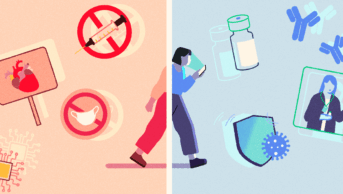
Shutterstock.com
As the saying goes, you never get a second chance to make a first impression and, with most of us making an almost instantaneous decision about someone within the first few seconds of meeting them, how you look is bound to have an impact on how you are perceived.
But does this mean pharmacists should wear white coats and serious expressions in order to come across as trusted professionals?
Not necessarily, according to Yvonne Tuckley, Numark’s learning and development manager. “For pharmacists, what they wear is all about striking the right balance between looking professional and approachable,” she says, “but a professional image doesn’t mean wearing a white coat nowadays, and it is debateable whether some customers would find this intimidating.”
She believes that smart and presentable clothing is a must: “In the same way that a disorganised and tatty shop can put customers off bringing in their prescriptions, inappropriately dressed staff can do the same. We all know that first impressions count for a lot and this could be the difference between whether or not a customer approaches you for advice or asks the questions they want to.”
However, the problem with clothing is that it can be subjective. “What is smart to one person could be scruffy to another,” says Tuckley, “and what looks smart on one person may not necessarily look smart on another.”
She also advises it is important to bear in mind the location you are working in: “For example, if your pharmacy is dealing with a student population they will have different attitudes than, perhaps, the elderly or those working in a business district.”
Ash Soni, Royal Pharmaceutical Society President and owner of Copes Pharmacy in London, agrees that dress choices should be suitable for the environment and the people you are working with and for.
“Because, historically, healthcare was obviously paternalistic there was the assumption that suitable clothing was a shirt and tie but, as we’ve seen, this is changing. Dress codes these days are dictated more by thinking about your environment, so dressing in a way that’s not going to cause offence should be key,” he says. “Think about who is coming to see you and make sure you’re dressed appropriately for the type of people who are using your service.”
At the same time, Soni stresses that your number one consideration should still be how you act. “The way you behave is the single most important thing,” he says. “After all, you could be dressed in a suit and be rude, or dressed in jeans and be sympathetic.”
Perception of professionalism
Although a white coat may have once been a mark of professionalism, another reason to shun it comes from studies which claim that it intimidates patients and can contribute to the anxiety of a consultation, hence the term and syndrome known as “white coat hypertension”, where patients show elevated blood pressure in clinical settings.
Another study into the influence of clothing in pharmacy, carried out by the American Pharmacists’ Association in 2005, measured patients’ reactions to consultations in a community pharmacy with a male pharmacist dressed in different styles — formal (shirt and tie), business casual (khaki trousers and a polo shirt) casual (jeans and T-shirt), and in a white coat.
The study found that only the level of communication affected how the pharmacist was perceived. Dress style and whether or not the pharmacist wore a white coat made no significant difference, leading the researchers to conclude that dress is not likely to influence a person’s evaluation of a pharmacist.
A uniform look
White coats may not be a useful dress choice these days, but staff uniforms can still have a role to play, Soni explains. “When they come into your pharmacy, people need to be able to easily identify staff from customers. Big stores, especially, use uniforms to help customers feel comfortable in knowing who to talk to and, again, the thinking behind this is all about giving customers confidence in the staff,” he says.
Some organisations opt for staff wearing their own clothes but in a selection of corporate colours, or ask employees to wear black trousers or skirts with a company supplied shirt or tunic on top, in order to give staff a distinct identity on the shop floor and enable clearer lines of communication with customers.
Tuckley points out that this also has some benefits for staff, saying: “Staff themselves are often grateful to have the decision of what to wear taken out of their hands, and there is a psychology associated with uniform-wearing that helps put people in the mindset for work and creates a division between this and their time away from the pharmacy.”
Confidence building
Younger or newly registered pharmacists, in particular, may find that choosing to dress smartly can help them feel more confident and professional while they find their feet in a new working environment.
“There is a mantra ‘dress for the job you want, not the job you have’,” says Tuckley, “which is good advice, especially early on in your career and the more junior you are. Many people associate youth with inexperience and, sadly, lack of knowledge. Avoiding overtly youthful or casual clothing will help counteract any of these negative perceptions.”
But while formal wear might make younger people feel more confident, Soni adds: “It’s about what gives you the confidence to do the job the best you can but doesn’t make you feel superior, because your role is to be engaging and not talking science in a way that confuses people.” He emphasises: “Communication and good listening skills are more important — you have to make sure people know that you are hearing what they are saying.”
Religious dress
Employers who wish to adopt a dress code have to make sure that it does not contravene the Employment Equality (Religion or Belief) Regulations 2003, with the Advisory, Conciliation and Arbitration Service (ACAS) pointing out that general dress codes that conflict with religious requirements may constitute indirect discrimination unless they can be justified.
Tuckley’s advice to owners and managers in independent pharmacies is to have a clothing policy and make new members of staff aware of the rules because, she says: “It is far easier to deal with this issue in advance rather than having to have an uncomfortable conversation with someone about their appearance.”
Even when it comes to dress associated with religious beliefs, Soni says your decision on what to wear should, ideally, be based on making people comfortable and not dressing in a way that causes a ‘barrier’ to that.
“We should all recognise religious belief and the ability to dress as you feel appropriate,” he says, “but again recognise the impact that will have on your customer; if they will find it difficult or offensive then that’s something you shouldn’t do. It’s about your ability to have good communication with your customers because they are not patients, they are people. In the end, what’s important is their view about how you interact with them.”
Interview etiquette
When deciding what to wear for interviews you’ve got to take a different angle again. “Think about who is going to interview you and their level of seniority,” says Soni, “and think what you would expect them to expect because you’re trying to sell yourself. What will make you most saleable in a professional way? It doesn’t hurt to be smart, but if it makes you really uncomfortable then it’s not appropriate. After all, you’re selling your capability, not your appearance.”
Of course, attire is only one element of being a credible source of information for your customers, and, as Soni says: “There will always be someone who thinks you’ve made the wrong choice but it’s your responsibility.
“In the end, it’s not what you’re wearing but how you’re acting that makes the biggest impression.”
Bare below the elbow
While there is no conclusive evidence that uniforms or other work clothes pose a significant hazard in spreading infection, there is a growing concern amongst the public that there is a risk.
Hygiene and infection control are important — especially if you are working in an area with sick people — which is another reason why a white coat and long sleeves are not appropriate.
The “Bare below the elbow” initiative from the Department of Health aims to counter these concerns, and any risks, by requiring anyone who has contact with patients or who works in clinical areas to wear short sleeves or ensure that long sleeves are securely rolled up, and wrist watches and jewellery (other than a plain metal wedding band) are removed.


